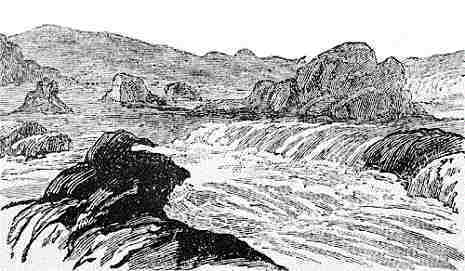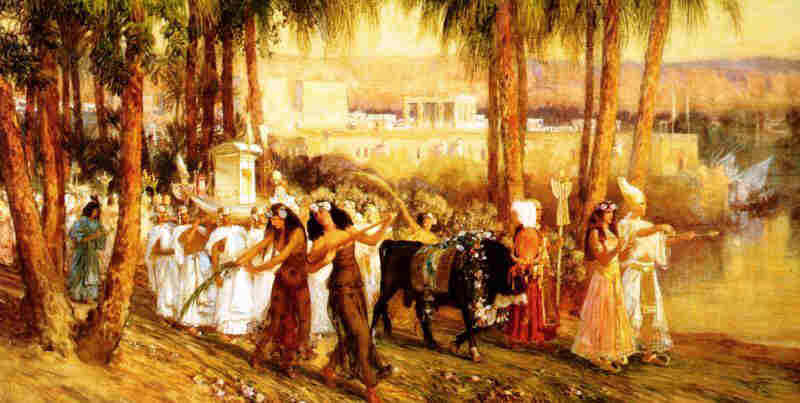The Symbols of Anuket - Her crown
Anuket was immediately recognised by her depictions in which she wore the distinctive and unusual headdress of tall ostrich feathers. Anuket is closely connected with Nubia, with the title "Mistress of Nubia", and lands south of Egypt and this is highly relevant to her style of headdress. The picture below shows an African headdress worn by a chief and the similarity between this and the crown of Anuket is clear. Her crown base for her headdress is called a modius and was used for the base of headdresses of male and female gods - refer to Crowns of Egypt. The dwarf god Bes was also believed to be of African origin was also depicted wearing a similar crown. Old African Headdress and the Crown of Anuket The Symbols of Anuket - The Gazelle
Another symbol associated with Anuket as the goddess of the hunt was the gazelle which was reflected in her tit;e "Lady of the Gazelle". The symbol of her mother Satet, another hunting goddess, was the antelope. Both of these animals were found grazing on the banks of the southernmost parts of the River Nile. Anuket - Goddess of the Cataracts
Anuket was the Egyptian goddess of the Nile cataracts and cultivated lands and fields. Anuket was particularly associated with the lower cataracts near Aswan. A cataract consists of rocky islets, waterfalls, whirlpools, or white water rapids. There were six cataracts along the River Nile. Only one cataract was in Egypt (Aswan) the other treacherous stretches of the Nile were in Nubia (aka Kush or Ethiopia), now Sudan. The cataracts were so dangerous that they were impassable except in seasons of high flood. The northernmost cataract of the Nile was on the border between Egypt and Nubia. Anuket was the goddess of all lands south of the Egyptian border and widely worshipped in Nubia, and given the title "Mistress of Nubia". A temple dedicated to Anuket was erected on the Island of Seheil. Inscriptions show that a shrine or altar was dedicated to her at this site by the 13th dynasty Pharaoh Sobekhotep III. The island called Elephantine, located in the Nile just north of the first cataract, was where the cult of Anuket, Satet and Khnum originated. 
Anuket and the Elephantine Triad
As the River Nile flowed towards the north, the annual flood waters entered Egypt by passing Elephantine and by the 18th Dynasty it became the cult center for the three gods: Anuket, the goddess of the cataracts, her mother Satet the war goddess of the flood or inundation and her father Khnum the water god who guarded and controlled the waters of the Nile. These three gods were the protectors of the River Nile and known collectively as the Elephantine Triad. Elephantine was the capital of the state and for many years was the military stronghold of the Ancient Egyptian empire and a center of commerce and trade with the Nubians. The trading link with Nubia probably accounts for the name 'Elephantine' as there was a brisk trade in ivory at the island. Anuket the Water Goddess
As the Egyptian goddess of the treacherous Nile cataracts Anuket was particularly worshipped by the ancient Egyptian traders and sailors who left inscriptions on the rocks as a form of prayers to Anuket for their safe passage along the hazardous waters to Nubia or for their safe return to Egypt. The River Nile provided the source of agricultural wealth to ancient Egypt. Each year a torrent of water overflowed on to the banks of the Nile leaving a thick rich mud (called black silt) and alluvial soil that fertilized the land making it ideal for growing the crops that fed Egypt. The flooding of the Nile was of such importance that the Egyptians based their lives around it. - Akhet was the time of the Nile flood (June - September)
- Peret was the sowing time (October - January)
- Shemu was the time of harvest (February - May)
The Festival of Anuket
The beginning of the harvest season, Shemu, was celebrated with the Festival of Anuket in which thanks were given for the harvesting of food crops such as wheat and barley, and industrial crops, such as flax and papyrus. Celebrations during the Festival of Anuket included a magnificent river procession, in which the other members of the Elephantine Triad, Khnum and Satet, were also honored. Statues of the gods were removed from the temple and ceremoniously placed on gilded ceremonial barques, equipped with long poles that were carried on the shoulders of their priests to the bigger river boats. The massive processions consisted of standard bearing Egyptian soldiers, priests, musicians, singers and dancers. Festivals were extremely noisy with shouting people, the chants of the temple choir, the blowing of trumpets, the beating of drums, the rattling of the sistra. The air would have been full of the smell of burning incense. Statues of other gods were added to the procession as different temples were passed. The people would enjoy the spectacle of the procession and celebrate with feasting. The people also gave offerings to the gods by throwing such items as jewelry and coins into the Nile to honor and appease the river gods. 
Ancient Egyptian Festival Procession |